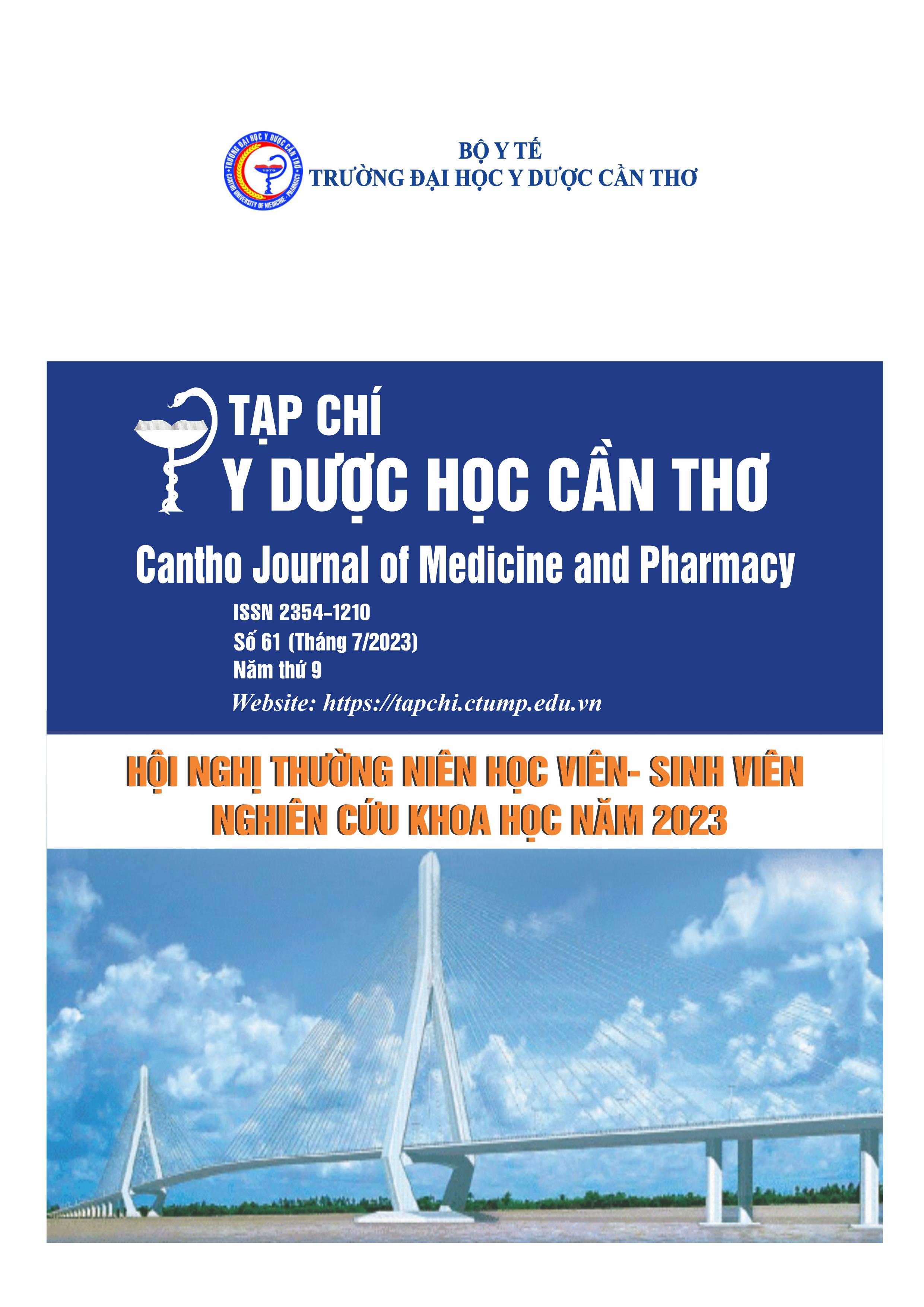NGHIÊN CỨU TỈ LỆ NHIỄM CHLAMYDIA TRACHOMATIS VÀ MỘT SỐ YẾU TỐ LIÊN QUAN Ở PHỤ NỮ MANG THAI 3 THÁNG ĐẦU TẠI BỆNH VIỆN PHỤ SẢN THÀNH PHỐ CẦN THƠ NĂM 2021-2023
Nội dung chính của bài viết
Tóm tắt
Đặt vấn đề: Các bệnh lây truyền qua đường tình dục là một trong những bệnh lây truyền phổ biến nhất trên toàn thế giới, trong đó Chlamydia là bệnh có tỉ lệ lây nhiễm đứng hàng đầu. Ở phụ nữ mang thai, nhiễm Chlamydia có thể dẫn đến các kết cục thai kỳ và kết cục sơ sinh bất lợi. Mục tiêu nghiên cứu: Xác định tỉ lệ nhiễm Chlamydia trachomatis và tìm hiểu một số yếu tố liên quan ở phụ nữ mang thai 3 tháng đầu. Đối tượng và phương pháp nghiên cứu: Thiết kế nghiên cứu cắt ngang mô tả có phân tích, khảo sát 350 phụ nữ mang thai 3 tháng đầu, từ 7/2021 đến 6/2023 tại Bệnh viện Phụ sản Thành phố Cần Thơ. Kết quả: Tỉ lệ nhiễm Chlamydia trachomatis ở phụ nữ mang thai 3 tháng đầu là 4% (14/350 trường hợp). 57,1% thai phụ nhiễm Chlamydia trachomatis không có triệu chứng. Đối tượng có từ 2 bạn tình trở lên nhiễm Chlamydia trachomatis tăng gấp 5,84 lần (OR = 5,836; KTC 95%: 1,472-23,143) với p = 0,029. Đối tượng có tiền sử viêm nhiễm đường sinh dục dưới tăng nguy cơ nhiễm Chlamydia trachomatis gấp 3,38 lần (OR = 3,381; KTC 95%: 1,132-10,099) với p = 0,033. Kết luận: Tỉ lệ nhiễm Chlamydia trachomatis ở phụ nữ mang thai 3 tháng đầu là 4%. Đa số thai phụ nhiễm Chlamydia trachomatis không có triệu chứng. Các phụ nữ có từ 2 bạn tình trở lên và phụ nữ có tiền sử viêm nhiễm đường sinh dục dưới đều có liên quan đến nhiễm Chlamydia trachomatis ở phụ nữ mang thai 3 tháng đầu.
Chi tiết bài viết
Từ khóa
Chlamydia trachomatis, nhiễm Chlamydia, 3 tháng đầu thai kỳ
Tài liệu tham khảo
2. World Health Organization. WHO guidelines for the treatment of Chlamydia trachomatis. 2016.
3. Wynn A., Bristow C. C., Cristillo A. D., Murphy S. M., va den Broek N., et al. Sexually Transmitted Infections in Pregnancy and Reproductive Health: Proceedings of the STAR Sexually Transmitted Infection Clinical Trial Group Programmatic Meeting. Sex Transm Diseases. 2020. 47(1), 5-11, doi: 10.1097/OLQ.0000000000001075.
4. Davey D. L Joseph, Shull H. I., Billings J. D., Wang D., Adachi K., et al. Prevalence of Curable Sexually Transmitted Infections in Pregnant Women in Low- and Middle-Income Countries From 2010 to 2015: A Systematic Review. Sex Transm Diseases. 2016. 43(7), 450-458, doi: 10.1097/OLQ.0000000000000460.
5. Nguyen Minh, Le Giang M, Nguyen Hanh T. T, Nguyen Hinh Duc and Klausner J. D. Acceptability and feasibility of sexually transmissible infection screening among pregnant women in Hanoi, Vietnam. Sexual Health. 2019. 16(2), 133-138, https://doi.org/10.1071/SH18041.
6. Ong J. J., Chen M., Hocking J., Fairley C. K., Carter R., et al. Chlamydia screening for pregnant women aged 16-25 years attending an antenatal service: a cost-effectiveness study. BJOG: An International Journal of Obstetrics & Gynecology. 2016. 123(7), 1194-1202, https://doi.org/10.1111/1471-0528.13567.
7. Op de Coul E. L. M., Peek D., van Weert Y. W., Morré S. A., Rours I., et al. Chlamydia trachomatis, Neisseria gonorrhoea, and Trichomonas vaginalis infections among pregnant women and male partners in Dutch midwifery practices: prevalence, risk factors, and perinatal outcomes. Reproductive Health. 2021. 18(1), 132, https://doi.org/10.1186/s12978-021-01179-8.
8. Cabeza J., García P. J., Segura E., García P., Escudero F., et al. Feasibility of Chlamydia trachomatis screening and treatment in pregnant women in Lima, Peru: a prospective study in two large urban hospitals. Sex Transm Infect. 2015. 91(1), 7-10, doi: 10.1136/sextrans-2014-051531.
9. Li C., Tang W., Ho H. C., Ong J. J., Zheng X., et al. Prevalence of Chlamydia trachomatis Among Pregnant Women, Gynecology Clinic Attendees, and Subfertile Women in Guangdong, China: A Cross-sectional Survey. Open Forum Infect Dis. 2021. 8(6), ofab206, https://doi.org/10.1093/ofid/ofab206.
10. Cunningham F. Gary, Leveno K. J., Bloom S. L., Dashe J. S., Hoffman B. L., et al. Williams obstetrics. McGraw-Hill Education. 2018. 1945-1946.
11. Vallely L. M., Toliman P., Ryan C., Rai G., Wapling J., et al. Prevalence and risk factors of Chlamydia trachomatis, Neisseria gonorrhoeae, Trichomonas vaginalis and other sexually transmissible infections among women attending antenatal clinics in three provinces in Papua New Guinea: a cross-sectional survey. Sex Health. 2016. 13(5), 420-427, https://doi.org/10.1071/SH15227.
12. Goggins E. R., Chamberlain A. T., Kim T. G., Young M. R., Jamieson D. J., et al. Patterns of Screening, Infection, and Treatment of Chlamydia trachomatis and Neisseria gonorrhea in Pregnancy. Obstetrics & Gynecology. 2020. 135(4), 799-807, doi: 10.1097/AOG.0000000000003757.
13. Silveira M. F. D., Sclowitz I. K. T., Entiauspe L. G., Mesenburg M. A., Stauffert D., et al. Chlamydia trachomatis infection in young pregnant women in Southern Brazil: a cross-sectional study. Cad Saude Publica. 2017. 33(1), e00067415, https://doi.org/10.1590/0102-311X00067415.
14. Beckmann C. R. B., Ling F. W., Herbert W. N. P., Laube D. W., Smith R. P., et al. Obstetrics and gynecology. Lippincott Williams & Wilkins. 2013. 294-297.


